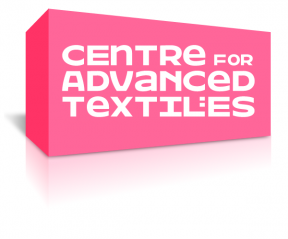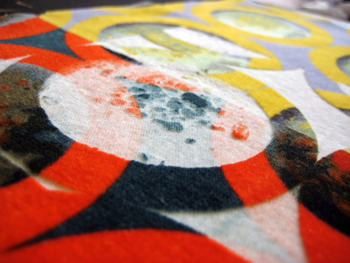 A couple of weeks ago I had the pleasure of a very extensive discussion with the guys at The Centre for Advanced Textiles (CAT) in this very city of Glasgow. CAT is a combined commercial/academic organisation housed within one of the Glasgow School of Art's design school buildings. It currently provides digital textile printing services to small and medium sized enterprises, whilst also quietly plotting a revolution in digital fabrication! I was speaking with researcher and interactions man, Andy McDonald, and surface designer JR.
A couple of weeks ago I had the pleasure of a very extensive discussion with the guys at The Centre for Advanced Textiles (CAT) in this very city of Glasgow. CAT is a combined commercial/academic organisation housed within one of the Glasgow School of Art's design school buildings. It currently provides digital textile printing services to small and medium sized enterprises, whilst also quietly plotting a revolution in digital fabrication! I was speaking with researcher and interactions man, Andy McDonald, and surface designer JR.
The centre currently has 2 large inkjet textile printers, as well as the use of the small laser cutter down in the product design workshop. We talked about digital processes for textiles in general, the pair's various projects in using digital processes for customisation, and the state of on-demand manufacturing.
Digital textiles
JR is most interested in design using natural fibres and has recently been exploring the use of lasers to engrave fabric. The resulting surface is surprisingly pronounced and consistent - check out the detail below. In this example JR has been combining the printing and engraving processes, and in another sample, using digital embroidery too. Explaining the differences in approach between product designers and surface designers, he says that he uses multiple processes to "obsessively build a surface, pushing things to where they're almost not usable". Quite apart from my product designer head that I guess aims to hone each part for economy and simplicity! Oh yeah, and usability.

For the embroidery, CAT are working with Interface, a research institute at the University of Ulster, Belfast experimenting with what JR describes as "any process digitally for textiles". Not bad.
It is quite interesting to mark the differences between what I regard as product manufacturing, and the world of garment manufacturing. For one thing textile products tend to be so transitory - my interviewees were soon to be heading off to a conference on Creative Commons applied to fashion as a medium, implying that fashion is a form of media more than anything else, the textile simply the carrier for information: Information that is changeable, trendy and peculiar to people or time. And as JR puts it, the manufacturers rely on this, often tolerating piracy as it ensures obsolescence.
JR cites Zara as an example of "brutally efficient mass production, perfected", a super fast response manufacturer, able to bring new items to shops within weeks. And he points out that as production and retail become closer, there comes a crossover point where it makes sense for retail to precede production. The item is bought and then produced on demand, and at this point there is the opportunity to make an item completely customised for the buyer. Hence CAT's interest in developing a platform for customers to commission customised textiles or garments using digital processes.
Andy takes the concept a step further: "Manufacturers see [on-demand manufacture] as a new way to mass produce - I see it as an alternative to mass production." In contrast to JR, Andy comes from a manufacturing engineering background and summarises his research in this way:
"I'm investigating how web-based interface technologies can be used in conjunction with existing digital design [software] and manufacturing [hardware] systems to deliver a more accessible, sustainable and responsible alternative to mass production. The study focuses primarily on the textiles & apparel supply chain for a number of reasons but I feel the model I am conceptualising is certainly applicable to any craft-based product given the correct fabrication capability."
An early paper that Andy delivered on this topic can be read on the excellent P2P Foundation wiki here.
I shall go into more detail about some of CAT's specific research projects in the next post.



No comments:
Post a Comment